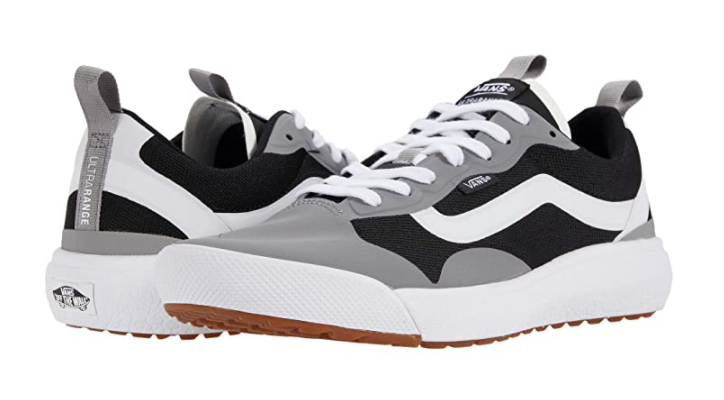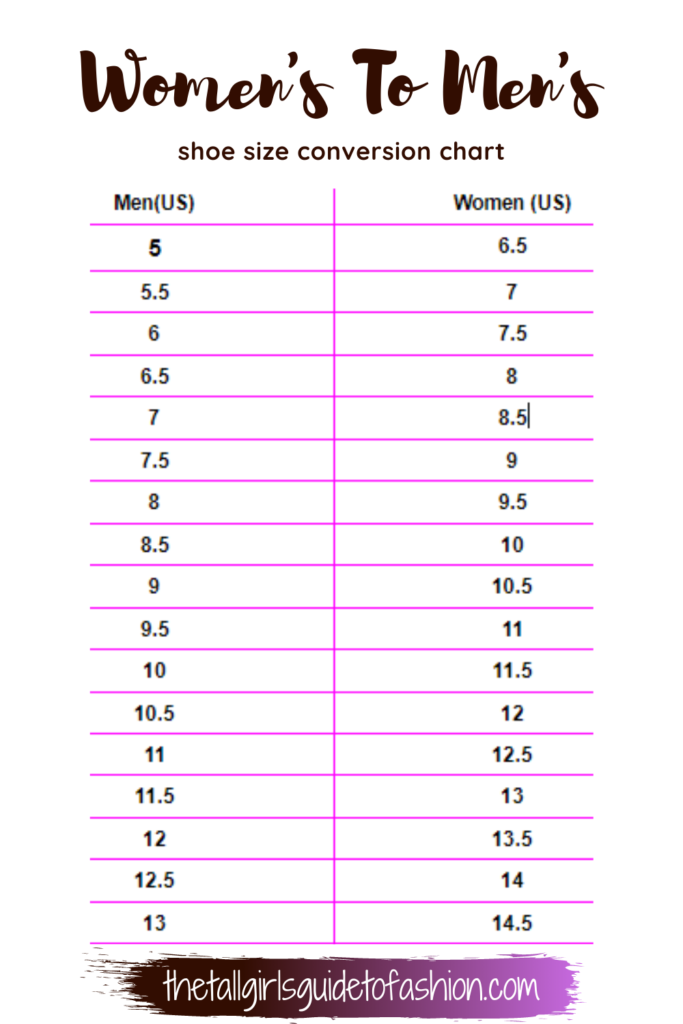This post may contain affiliate links. This means I may receive a small commission if products are purchased through them. All opinions are honest and remain my own.
If you’re curious what the difference between men’s vs. women’s shoe sizes is and how to convert between the two, it can be tricky to know the exact size equivalents since all shoe brands run differently. However, there is a general rule you can follow to get a pretty good idea of which size you’ll need.

In general, there is about one and a half size difference between the men’s and women’s shoe sizes. For example, a women’s size 10 would be a men’s 8.5, and a men’s 10 would be a women’s 11.5. However, in certain brands, there’s only a 1 size difference between the two.
Convert Women’s to Men’s Shoes, Quick Guide
What’s the difference between men’s and women’s shoes?
Men’s shoes are made larger and wider than women’s shoes and come in larger sizes. It’s very common to find men’s shoes up to a size 16+. Women’s shoes are made smaller and narrower. It’s hard to find them beyond a size 10 or 11.
The reason for this is just because generally speaking, men have larger feet. (Even though that isn’t always the case!)
The exact difference in sizing will vary depending on the brand, but in general, there’s about 1.5 sizes difference between the two departments.
- Men’s size 7 roughly equivalent to a women’s 8.5
- Men’s size 7.5 roughly equivalent to a women’s 9
- Men’s size 8 roughly equivalent to a women’s 9.5
- Men’s size 8.5 roughly equivalent to a women’s 10
- Men’s size 9 roughly equivalent to a women’s 10.5
- Men’s size 9.5 roughly equivalent to a women’s 11
- Men’s size 10 roughly equivalent to a women’s 11.5
- Men’s 10.5 roughly equivalent to a women’s 12
- Men’s 11 roughly equivalent to a women’s 12.5
- Men’s 11.5 roughly equivalent to a women’s 13
- Men’s 12 roughly equivalent to a women’s 13.5
- Men’s 12.5 roughly equivalent to a women’s 14
This conversion rule is NOT ALWAYS true…
You can follow the 1.5 size conversion rule from men’s to women’s shoes to get a better idea of what size you would need. However, it should be noted that this is not universally true across brands.
For example, I wear a women’s size 13 shoes. Since it’s extremely difficult to find that size, I sometimes just wear men’s shoes (especially when it comes to tennis shoes).
According to the above conversion chart, I would wear a men’s 11.5. While it usually works, sometimes I have to size up to a 12 or 12.5, just depending on the brand.
It can also depend on factors like the particular fit of the shoe and how wide it runs. And if you look at specific shoe manufacturer’s websites, you’ll notice that sometimes they’ll say there is only 1 size difference between men’s and women’s footwear.
This is why it’s so important to try on many shoes and just get a feel for how different brands and styles fit. Once you find a brand that fits you well – whether it’s women’s or men’s – stick with it. It makes shopping for shoes so much easier in the future and especially when it comes to online shopping.
Read also: Where to Find Shoes for Women with Big Feet
Women’s vs. Men’s shoe widths
In addition to being longer in length, men’s shoes are also a full width wider than women’s. So a men’s average width would be the same as a women’s wide width. A men’s average is commonly labeled “D” and a women’s wide also “D”.
However it is different across brands.
Sometimes a women’s and men’s regular are both labeled “M” for medium width. Other times women’s medium/regular width is designated by the letter A.
WOMEN’S SHOE WIDTHS
| 3A, AAA, S | x-narrow or slim |
| 2A, AA, N | narrow |
| A, B, M | regular |
| C, D, W | wide |
| 2E, EE, 2XW | x-wide |
| 4E, EEEE, 4XW | xx-wide |
MEN’S SHOE WIDTHS
| 2A, AA | x-narrow |
| B, C | narrow |
| D, M | regular |
| 2E, EE, W | wide |
| 4E, EEEE, XW | x-wide |
| 6E, EEEEEE, XXW | xx-wide |
This is pretty confusing considering the variation among brands. The important takeaway here is that men’s shoes are a full width wider than women’s, so always take that into consideration when converting between sizes.
Also check out: Guide to Shoe Widths – What Do They All Mean?!
Comparing shoes between brands is easier
Another thing to consider is that converting women’s and men’s shoe sizing between brands is much easier than between different brands.
For example trying to convert between New Balance and Nike will be more difficult without trying the shoes on because their sizing runs different. In my experience, Nike runs very small and narrow compared to other brands. I find their men’s shoes run more closely to women’s sizing, somewhere between 1/2 – 1 size different.
How to know which unisex shoe size to wear
Unisex shoes are just shoes that are sized exactly the same for men and women. Usually they list the men’s size and corresponding women’s size together, so you know which size to pick. If you only see one size listed, it’s a men’s size and you’ll need to follow the size conversion or look at size charts.
Since unisex shoes follow men’s sizing, they run wider than women’s shoes. If you’re a women with narrower feet, you may not find these shoes the best fit.
The Bottom Line
Because all brands and styles can fit differently, it’s difficult to do an exact conversion between men and women’s footwear sizes. However, knowing that there is usually a 1.5 size difference can give you a better starting point.
Read also: Shopping Guide for Women’s Extended Shoes Size 12, 13, 14+

Leave a Reply